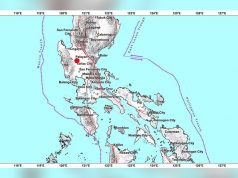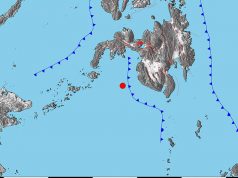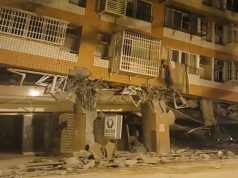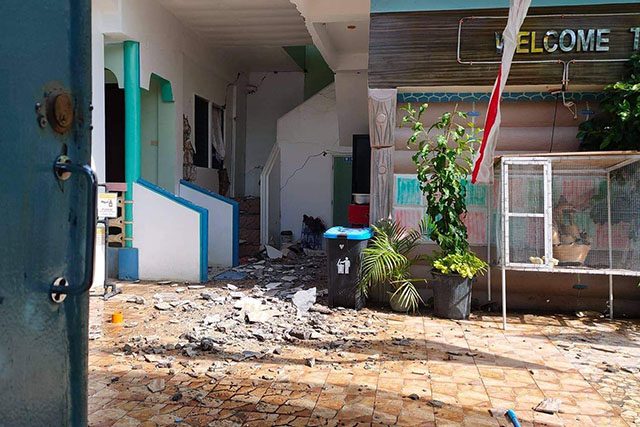
A science organization on Tuesday corrected viral posts that led the public to imply the announced alert levels of the volcanoes were related to the magnitude 6.6 earthquake that rocked Masbate on Tuesday morning.
Earth Shaker Philippines tagged the social media posts as “misleading” and said that Alert Level One has long been raised in Mayon Volcano, Bulusan Volcano, Taal Volcano and Kanlaon Volcano.
“CLARIFICATION: Matagal nang nasa Alert Level 1 ang mga bulkang Mayon, Taal, Kanlaon, at Bulusan. Hindi po sila biglang naging ‘abnormal’ kasabay ng M6.6 na lindol sa Masbate ngayong umaga,” the organization said in a Facebook post.
“Mag-ingat po tayo sa pagpost upang hindi magdulot ng panic,” it added on Twitter.
It proceeded to note that the four volcanoes have been under Alert Level 1 since the following, as reported by the Philippine Institute of Volcanology and Seismology on July 17:
- Mayon Volcano: July 17, 2020
- Taal Volcano: March 19, 2020
- Kanlaon Volcano: March 11, 2020
- Bulusan Volcano: July 6, 2020
The organization mentioned that the state geotectonic monitoring agency regularly releases advisories on the four volcanoes every 8:00 a.m.
“Kaya nakitang inilabas ang mga Volcano Bulletin malapit sa oras ng malakas na lindol ngayong umaga ay dahil UMAGA TALAGA INILALABAS ng PHIVOLCS ang mga bulletin na ito. Araw-araw silang naglalabas nito,” Earth Shaker said.
CLARIFICATION: Matagal nang nasa Alert Level 1 ang mga bulkang Mayon, Taal, Kanlaon, at Bulusan. Hindi po sila biglang…
Posted by Earth Shaker on Monday, August 17, 2020
The organization in its Facebook post tagged a social media post showing a screengrab from the page of an FM radio station which reported on the alert levels of the volcanoes.
It simultaneously reported that a magnitude 6.6 earthquake rocked the town of Cataingan in Masbate in the Bicol Region. It reads:
JUST IN (updated 10:48 a.m.): Phivolcs reported this morning that Kanlaon, Bulusan, Taal, and Mayon Volcanoes are under Alert Level 1, which means that abnormal activity has been recorded in all four volcanoes.
The advisory came just minutes before a magnitude 6.6 earthquake was recorded in Masbate, with tremors felt in parts of Negros Island.
This morning, Taal Volcano let off steam.
An entertainment website likewise reported on the volcanoes’ alert levels and the earthquake on the same social media post.
Such posts prompted some Filipinos to wrongly perceive that the volcanoes’ alert levels were supposedly raised in connection to the Masbate quake that happened on Tuesday morning.
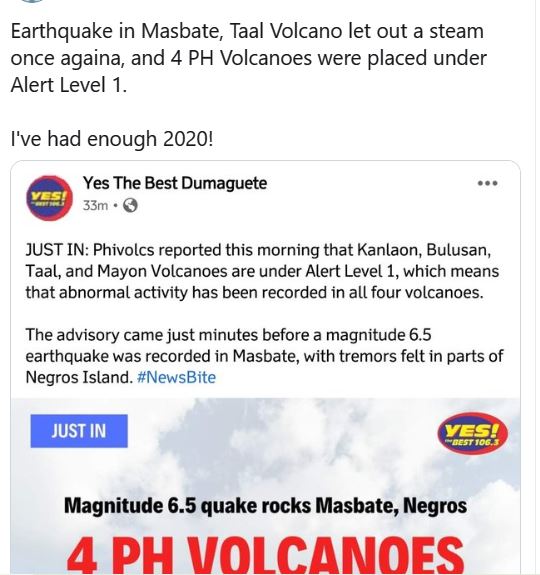
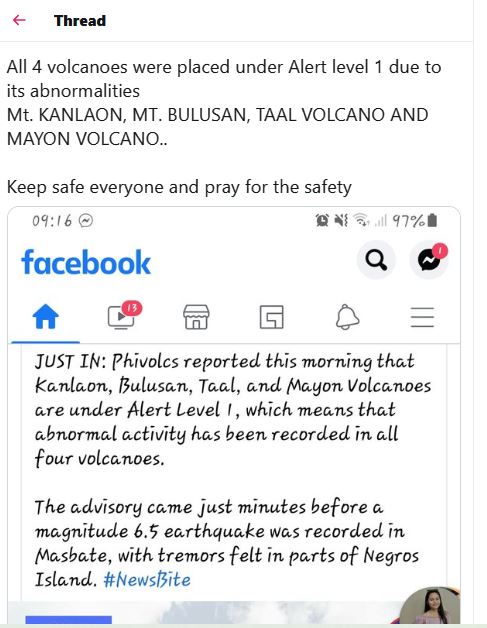

Twitter user @aikovinclerigo, who claims of “someone who’s been following DOST-PHIVOLCS’ FB (Facebook) page for a long time,” reminded the public that it was just a “coincidence” that the Masbate earthquake happened minutes after the daily release of advisories.
“DOST-PHIVOLCS posts updates on these volcanoes every morning so it’s just a coincidence that the updates were posted before the M6.5 quake in Masbate,” she wrote.
The online user also reminded the public that the Philippines is on the Ring of Fire or the “path along the Pacific Ocean characterized by active volcanoes and frequent earthquakes,” according to National Geographic.
“Though it’s called abnormal activity, these things are actually not unusual since we’re in the ‘Ring of Fire’ so our volcanoes are mostly active,” she commented.
“Lastly, we should not panic but we should remain prepared and vigilant in case anything serious happens. Let’s keep safe by keeping ourselves informed,” the online user added.
What happened?
CNN Philippines at 8:21 a.m. today shared a sourced video of what it said was Taal Volcano letting out “steam.”
The Batangas-based volcano previously made headlines when it erupted last January.
Phivolcs officer-in-charge Renato Solidum Jr. clarified that the Masbate earthquake was not related to Taal Volcano’s activity on Tuesday morning.
“Araw-araw bumubuga ng usok ang Taal, kahit bago pa ang January eruption. Ito ay normal na pangyayari. Binabantayan natin ang pamamaga ng bulkan. Normal po ang pag-usok ng Taal,” he said in an interview.
Phivolcs likewise clarified that some pictures circulating on social media are of a “cloud formation in Batangas.”
LOOK: Snapshots from real-time IP cameras monitoring activity at #TaalVolcano Island. Only 20 m-high plumes from active fumaroles on the Main Crater have been emitted all morning, & photos circulating in social media are actually of a cloud formation on mainland Batangas Province pic.twitter.com/fFGHMpAmxv
— PHIVOLCS-DOST (@phivolcs_dost) August 18, 2020
The agency added that the Taal Volcano only emitted 20-meter plumes which are expected under its current alert level status.
“DOST-PHIVOLCS reminds the public that at Alert Level 1, sudden steam-driven or phreatic explosions, volcanic earthquakes, minor ashfall, and lethal accumulations or expulsions of volcanic gas can occur and threaten areas within the Taal Volcano Island,” its morning advisory on Tuesday said.
Phivolcs usually releases the daily advisories on four volcanoes, including Taal Volcano, at 8:00 a.m.
Masbate quake
Meanwhile, the town of Cataingan in Masbate experienced a magnitude 6.6 earthquake at 8:03 a.m.
It was initially recorded as magnitude 6.5 but state seismologists upgraded it to 6.6
Phivolcs reported that the earthquake was tectonic in origin and was located seven kilometers southwest of Cataingan.
Solidum said that the tremor was caused by a movement in the Masbate segment of the Philippine fault.
The institute said that the Philippine fault zone is a major tectonic feature that transects the whole archipelago from northwestern Luzon to southeastern Mindanao.
It is divided into several segments and has been the source of large-magnitude earthquakes which include the 1990 Luzon earthquake and the 2003 Masbate earthquake.
The Tuesday’s earthquake was felt at various intensities in parts of Luzon and Visayas.
READ: Strong quake strikes eastern Philippines, reports of damage
The highest intensity recorded was in Cataingan at Intensity VII which was seen as “destructive.”
Intensity VII causes heavy objects and furniture to overturn or topple while old or poorly-built structures suffer considerable damage.




